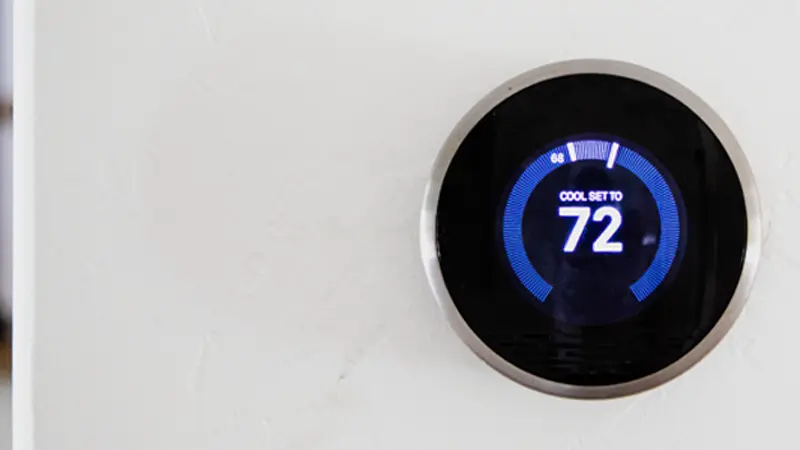If you live in a region with a generally mild climate, you might wonder about the relevance of smart thermostats in your home. While these intelligent devices are often associated with managing heating systems in colder climates, they offer a multitude of benefits for those in more temperate areas as well.
Table of Contents
What Are Smart Thermostats?
Smart thermostats are modern, digital devices that revolutionize the way we control our home heating and cooling systems. Unlike traditional thermostats, these smart counterparts bring a new level of convenience, energy efficiency, and customization to your living space.
Benefits of Smart Thermostats
Efficient Energy Use
Smart thermostats are designed to optimize energy consumption. By learning your habits and preferences, these devices create tailored schedules, preventing unnecessary heating or cooling when it’s not needed. The result? Substantial cost savings on your energy bills.
Remote Control and Monitoring
With the ability to control your thermostat remotely through a smartphone app, you gain real-time insights into your energy usage. This not only fosters a more conscious approach to energy consumption but also empowers you to make informed decisions for further cost efficiency.
Learning Capabilities
Smart thermostats adapt to your lifestyle. Their learning capabilities analyze your behavior and adjust settings accordingly. This means waking up to a warm home in the morning and returning to a comfortably cool space in the evening—personalized comfort tailored to your routine.
Customizable Schedules
Create personalized schedules based on your daily activities. Whether at work, sleeping, or enjoying a weekend at home, your smart thermostat ensures the perfect temperature, aligning with your preferences and maximizing comfort.
Reduced Carbon Footprint
The efficiency of smart thermostats translates into a reduced carbon footprint. These devices contribute to a more sustainable and environmentally conscious way of living by minimizing energy waste.
Integration with Eco-Friendly Practices
Many smart thermostats integrate with other smart home devices, enhancing overall eco-friendliness. For example, they can collaborate with smart lighting systems, ensuring lights are off in unoccupied rooms, further minimizing energy consumption.
Top Smart Thermostat Brands
Nest Learning Thermostat
Pioneering Learning Algorithms: Nest, a Google subsidiary, revolutionized smart thermostats by introducing learning algorithms. The Nest Learning Thermostat adapts to user behavior, optimizing schedules for maximum comfort and efficiency.
Ecobee SmartThermostat
Precision with Sensors: Ecobee’s SmartThermostat is acclaimed for its sensor-packed design, allowing room-specific temperature monitoring and occupancy detection. This precision enables tailored climate adjustments for enhanced comfort.
Honeywell Lyric
Geofencing Capabilities: Honeywell’s Lyric line takes climate control to the next level with geofencing. Adjusting temperatures based on user proximity, it ensures a comfortable environment upon arrival and energy savings when away.
Emerson Sensi Thermostats
Simplicity Meets Smart Features: Emerson’s Sensi thermostats strike a balance between simplicity and intelligence. Easy to use, they don’t compromise on smart features, providing an accessible entry into smart climate management.
These notable brands have not only set the standard but continue to innovate, offering a diverse range of features that cater to various preferences and lifestyles. Whether it’s learning algorithms, precise sensors, geofencing, or user-friendly simplicity, these smart thermostat brands redefine how we control and experience home comfort.
Installing Smart Thermostats: A User-Friendly Guide
Smart thermostats bring advanced climate control to your fingertips, but the installation process need not be a mystery. Whether you’re a DIY enthusiast eager to take on the challenge or prefer the ease of professional installation, this guide demystifies the setup process, ensuring your smart thermostat is up and running seamlessly.
DIY Installation:
- Assess Compatibility
- Before embarking on the installation, check your HVAC system compatibility. Confirm that your smart thermostat is suitable for your heating and cooling setup.
- Turn Off Power
- For safety, turn off the power to your HVAC system at the breaker. This ensures a secure environment for the installation process.
- Label Existing Wires
- Label the existing wires connected to your current thermostat. This step is crucial for a smooth transition to the new smart thermostat.
- Remove Old Thermostat
- Carefully remove the old thermostat from the wall. Please take note of the labeled wires and disconnect them one by one.
- Install New Thermostat
- Follow the manufacturer’s instructions for wiring your new smart thermostat. Secure it to the wall and ensure a snug fit.
- Connect to Wi-Fi
- Power on the thermostat and connect it to your Wi-Fi network. This step is essential for remote control and smart features.
- Configure Settings
- Use the thermostat’s interface or a dedicated app to configure settings such as language, temperature units, and any personalized preferences.
Professional Installation:
- Schedule a Professional
- If DIY is not your preference, many manufacturers offer professional installation services. Schedule an appointment with a certified technician.
- HVAC System Check
- The technician will assess your HVAC system to ensure compatibility with the smart thermostat. They may also perform any necessary upgrades or adjustments.
- Wiring and Installation
- The professional will handle the wiring and physical installation of the smart thermostat, ensuring seamless integration with your HVAC system.
- Network Connection
- They will connect the thermostat to your Wi-Fi network, enabling remote access and smart features.
- Testing and Calibration
- After installation, the technician will test the thermostat to ensure it’s functioning correctly. They may also calibrate the system for optimal performance.
- User Tutorial
- Finally, the technician will provide you with a tutorial on using the smart thermostat, including any specific features or settings.
Whether you choose the hands-on approach or opt for professional assistance, installing a smart thermostat is a manageable task that opens the door to enhanced home comfort and efficiency.
Conclusion
As we conclude this exploration into smart thermostats, it’s clear that these devices offer a transformative approach to home comfort and efficiency. Whether you’re a tech enthusiast or someone new to smart home technology, the world of smart thermostats is ready to enhance your living space with intelligent temperature control.




